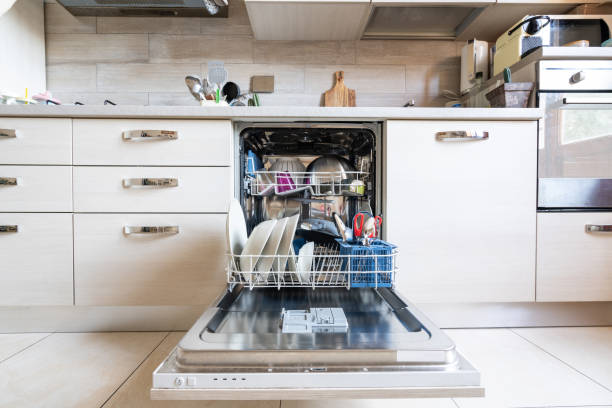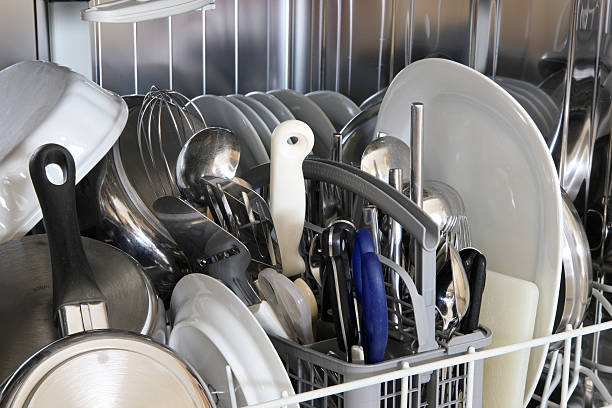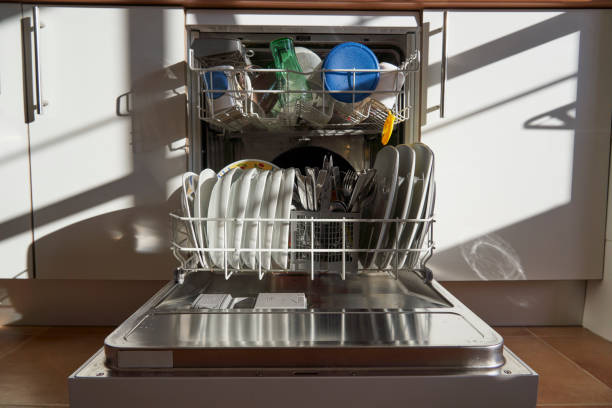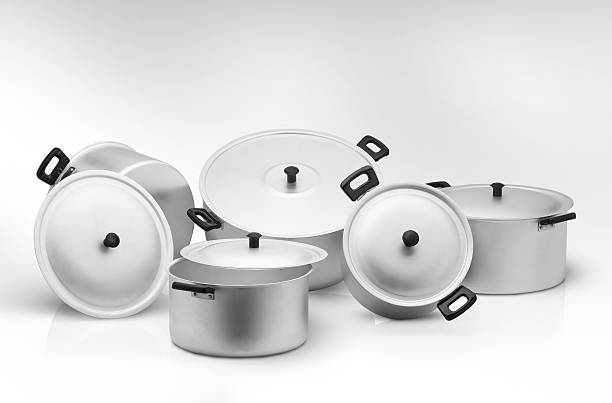In the bustling symphony of a modern kitchen, where culinary creations dance and sizzle, aluminum pans take center stage as versatile maestros.
However, imagine the crescendo of disappointment when, after a culinary masterpiece, these once-shining kitchen virtuosos emerge from the dishwasher with a disconcerting hint of discoloration.
The dishwashing encore turns into a puzzling drama, leaving us to wonder: Why do aluminum pans, those unsung heroes of our culinary exploits, undergo a chromatic metamorphosis in the heart of the dishwasher’s cleansing symphony?
Let’s unravel the mysterious overture of aluminum discoloration and discover the science behind this culinary enigma.

Why Do Aluminum Pans Get Discolored In The Dishwasher
Aluminum pans often discolor in the dishwasher due to a combination of factors such as alkaline detergents, minerals in water, and the reactive nature of aluminum.
Understanding the Chemical Dance: Alkaline Detergents and Aluminum Reactivity
In the quest for spotless dishes, many resort to powerful alkaline detergents in the dishwasher. While effective in removing grime, these detergents can trigger a chemical reaction with the aluminum surface.
This reaction, known as alkaline etching, leads to discoloration and a dull appearance on the once-shiny pans.
Water Hardness Woes: The Impact of Minerals on Aluminum’s Hue
Water, often overlooked in the dishwasher equation, plays a significant role in the discoloration saga. High mineral content, characteristic of hard water, exacerbates the problem.
The minerals interact with the aluminum, leaving behind stains and discoloration that persist despite regular cleaning.
Heat, Humidity, and Aluminum Oxidation: The Unseen Culprit
Aluminum pans exposed to the combined onslaught of heat and humidity within the dishwasher are prone to oxidation. This process forms a thin layer of aluminum oxide on the surface, contributing to the discoloration.
The repeated exposure to these conditions accelerates the oxidation, leaving an unmistakable mark on the once-pristine pans.
Preserving Pan Purity: Tips to Minimize Aluminum Discoloration in the Dishwasher
To safeguard your aluminum pans from the dishwasher’s discoloration onslaught, consider handwashing them with mild detergents.
Using water softeners, opting for low-alkaline detergents, and promptly removing pans after the dishwasher cycle can help maintain their original luster.
Taking these preventive measures ensures your aluminum pans stay vibrant and free from the unsightly stains caused by dishwasher-induced discoloration.
Types of Aluminum Cookware
Pressed Aluminum
Pressed aluminum cookware is another notable category, recognized for its affordability and lightweight nature.
These cookware items are crafted by pressing aluminum sheets into shape, resulting in pans and pots that are both durable and cost-effective. Pressed aluminum cookware is often praised for its quick and even heat distribution, facilitating efficient cooking.
Home cooks often appreciate the balance between performance and affordability that pressed aluminum cookware offers, making it a popular choice for daily culinary tasks.
When considering your kitchen arsenal, exploring the benefits of pressed aluminum cookware adds a budget-friendly and functional dimension to your cooking experience.
Cast Aluminum
Cast aluminum cookware stands out for its remarkable combination of durability and efficient heat distribution. Crafted through a process where molten aluminum is poured into molds, cast aluminum cookware boasts a robust construction that resists warping over time.
The result is cookware that heats up quickly and evenly, ensuring consistent cooking performance. Home chefs often praise the versatility of cast aluminum, as it can seamlessly transition from stovetop to oven.
With its non-reactive nature and resistance to rust, cast aluminum cookware is a reliable choice for those seeking long-lasting and high-performing kitchen essentials.
Explore the world of cast aluminum to elevate your cooking experience with dependable and resilient cookware.
Anodized Aluminum
Anodized aluminum cookware is celebrated for its enhanced durability and resistance to corrosion. Through a specialized electrochemical process, the surface of the aluminum is strengthened, creating a hard and non-reactive layer.
Hard-anodized aluminum cookware exhibits superior scratch resistance, making it suitable for use with metal utensils. Its non-stick properties and ability to withstand high temperatures make it ideal for various cooking styles.
Home cooks value the longevity and easy maintenance of anodized aluminum, appreciating its ability to endure daily wear and tear.
When seeking cookware that combines durability, versatility, and low-maintenance, exploring the benefits of anodized aluminum is a smart choice for any kitchen.
Dishwashers and Aluminum Cookware
When it comes to dishwashers and aluminum cookware, it’s crucial to consider compatibility and care. Most aluminum cookware is dishwasher-safe, but it’s recommended to hand wash to preserve its longevity.
While aluminum is resilient, harsh dishwasher detergents may affect its appearance over time. To maintain the integrity of your aluminum pots and pans, hand washing with mild soap is preferable.
Ensure your aluminum cookware is thoroughly dried after washing to prevent water spots. By adopting proper care practices, you can enjoy the convenience of dishwashers without compromising the durability and performance of your cherished aluminum cookware.

Dishwasher Safe Symbol
The dishwasher safe symbol is a universally recognized icon that simplifies the maintenance of kitchenware, providing consumers with valuable information about the compatibility of an item with dishwasher cleaning.
Typically represented by a small dish or utensil image surrounded by water droplets, this symbol reassures users that the particular item can withstand the rigors of dishwasher cycles without compromising its quality.
For many households, the presence of the dishwasher safe symbol on cookware, dishes, or utensils is a time-saving convenience. It allows users to streamline their kitchen cleanup process, promoting efficiency and ease in managing daily chores.
It is important for consumers to adhere to any specific care instructions provided by manufacturers, even if an item bears the dishwasher safe symbol, as certain materials or finishes may still require specific handling to maintain their longevity and performance.
Ultimately, the dishwasher safe symbol serves as a practical guide, enhancing the user experience and ensuring that kitchenware remains both functional and durable.
Advice on Putting Aluminum Pans in the Dishwasher
While many aluminum pans are labeled as dishwasher-safe, it’s essential to exercise caution and follow specific guidelines to maintain their longevity and performance. Here are some tips for safely putting aluminum pans in the dishwasher:
- Check the Manufacturer’s Instructions: Always refer to the manufacturer’s care instructions for your specific aluminum pans. These guidelines provide valuable information on whether the cookware is suitable for dishwasher use.
- Avoid Harsh Detergents: Choose mild and gentle dishwasher detergents to prevent potential damage to the aluminum surface. Harsh chemicals can affect the appearance and finish of the pans over time.
- Hand Wash for Longevity: Although many aluminum pans are dishwasher-safe, hand washing is often recommended to prolong their lifespan. Hand washing with a soft sponge, mild soap, and warm water allows for more careful cleaning and helps preserve the pan’s surface.
- Minimize Abrasive Scrubbers: Abrasive scouring pads or harsh scrubbers can scratch the surface of aluminum pans. Opt for soft sponges or brushes to avoid damaging the finish.
- Avoid High-Temperature Washes: Some dishwashers offer high-temperature wash settings that may be too intense for aluminum cookware. Stick to standard or gentle cycles to prevent potential warping or damage.
- Dry Thoroughly: After the dishwasher cycle is complete, promptly remove aluminum pans and thoroughly dry them. This prevents water spots and helps maintain the appearance of the cookware.
- Inspect for Damage: Regularly inspect your aluminum pans for any signs of damage, such as scratches, dents, or discoloration. If you notice issues, consider transitioning to hand washing or following any specific care recommendations provided by the manufacturer.
The Environment of the Dishwasher
The environment inside a dishwasher is a dynamic and purposeful space designed to efficiently and effectively clean a variety of kitchenware. Dishwashers operate by utilizing a combination of water, detergent, and heat.
When a cycle begins, water is sprayed onto the dishes and utensils to remove food particles and stains. The detergent aids in breaking down grease and grime, while the heat, either from the water or a heating element, helps sanitize and dry the items.
The dishwasher environment is optimized for cleaning, with carefully calibrated water pressure and temperature settings. The use of jets and rotating arms ensures that water reaches every surface of the dishes, providing a thorough cleaning.
Modern dishwashers often include sensors and smart technology to adjust the cycle based on the level of soiling, making them more efficient and environmentally friendly.
In terms of energy consumption, dishwashers today are designed to be more energy-efficient than handwashing, especially when using an energy-efficient dishwasher and running it with a full load. This can contribute to reducing overall water and energy usage in households.
Furthermore, the dishwasher environment plays a role in minimizing water wastage. Many dishwashers are equipped with sensors that detect the cleanliness of the rinse water. If the water is still relatively clean, it may be reused in later stages of the cycle, conserving water resources.
While the dishwasher environment is focused on functionality and efficiency, users can further enhance its eco-friendliness by selecting energy-efficient appliances, ensuring full loads, and following sustainable practices such as using eco-friendly detergents.
Overall, understanding and optimizing the dishwasher environment contribute to both effective cleaning and environmentally conscious living.

Proper Cleaning of Aluminum Pans
Cleaning aluminum pans properly is crucial to maintaining their performance and appearance. Follow these steps for effective and safe cleaning:
- Cool Down Before Cleaning: Allow the aluminum pan to cool down before cleaning to prevent burns and to avoid potential warping of the metal.
- Hand Wash with Mild Soap: Hand washing is often recommended for aluminum pans. Use a soft sponge or cloth and mild dish soap. Avoid using harsh abrasives or steel wool, as they can scratch the surface.
- Avoid Dishwasher Use if Not Recommended: Check the manufacturer’s instructions to determine if the aluminum pan is dishwasher-safe. If it is, use a gentle cycle and mild detergent to prevent damage.
- Remove Residue with Soft Tools: For stubborn food residues, soak the pan in warm, soapy water to loosen the debris. Use a soft brush or sponge to gently scrub away any remaining particles.
- Baking Soda Paste for Stains: For discoloration or stains, create a paste using baking soda and water. Apply the paste to the affected areas, let it sit for a while, and then scrub gently with a soft brush.
- Avoid Acidic Cleaners: Avoid using acidic or alkaline cleaners, as they can react with the aluminum and affect its surface. Stick to mild, neutral cleaners for optimal results.
- Dry Thoroughly: After washing, dry the aluminum pan thoroughly with a clean, dry cloth to prevent water spots and minimize the risk of corrosion.
- Regularly Inspect for Damage: Periodically inspect your aluminum pans for any signs of damage, such as scratches, dents, or discoloration. Address any issues promptly to maintain the pan’s integrity.
- Season if Necessary: If your aluminum pan is not coated with a non-stick surface, consider seasoning it with a thin layer of cooking oil. This helps prevent sticking and enhances the pan’s natural non-stick properties.
Problem Stains on Aluminum Pans
If you’re dealing with stubborn stains on your aluminum pans, here are some effective solutions to help restore them to their original condition:
- Baking Soda and Water Paste: Create a paste by mixing baking soda with water. Apply the paste to the stained areas and let it sit for a few hours or overnight. Scrub the stains gently with a soft brush or sponge, and then rinse thoroughly.
- Vinegar and Water Soak: Fill the aluminum pan with a mixture of equal parts vinegar and water. Allow it to soak for a few hours or overnight. The acidity of the vinegar can help break down stains. After soaking, scrub the stains with a soft brush or sponge and rinse well.
- Cream of Tartar and Lemon Juice: Make a paste using cream of tartar and lemon juice. Apply the paste to the stained areas, let it sit for some time, and then scrub gently. The acidity of the lemon juice, combined with the abrasive nature of cream of tartar, can help remove stains.
- Commercial Aluminum Cleaner: Consider using a commercial aluminum cleaner specifically designed for cookware stains. Follow the product instructions carefully, and be sure the cleaner is suitable for your type of aluminum pan.
- Boiling Water and Cream of Tartar: Boil water in the stained pan, adding a few tablespoons of cream of tartar. Let it simmer for 10-15 minutes. The heat and acidity can help lift stains. Afterward, scrub the stains with a non-abrasive sponge or brush.
- Aluminum Foil Scrub: Crumple a piece of aluminum foil into a ball and use it as a scrubber. Rub the stained areas gently. The foil’s abrasive nature, along with its aluminum composition, can assist in removing stains.
- Dish Soap and Steel Wool (for Anodized Aluminum): If dealing with stains on anodized aluminum, use a mild dish soap and fine steel wool. Be cautious not to use this method on regular aluminum, as steel wool may scratch its surface.
Additional Tips when cleaning aluminum pans
Certainly! Here are some additional tips to consider when cleaning aluminum pans:
- Use a Soft Cloth or Sponge: Opt for a soft cloth or sponge when cleaning aluminum pans to avoid scratching the surface. Abrasive materials can damage the finish and reduce the lifespan of the cookware.
- Avoid High Heat for Cleaning: While aluminum is generally resistant to high temperatures, extreme heat during cleaning can cause warping. Let the pan cool before cleaning and use warm, not boiling, water.
- Lemon and Salt for Brightening: For brightening aluminum surfaces, rub a cut lemon dipped in salt over the pan. The acidity of the lemon combined with the abrasive salt can help restore the shine.
- Regular Maintenance: Clean your aluminum pans regularly to prevent the build-up of stubborn stains. Prompt cleaning after each use can make the process easier and more effective.
- Avoid Dishwasher with Non-Stick Coating: If your aluminum pan has a non-stick coating, it’s often best to avoid the dishwasher, as harsh detergents and high heat can degrade the non-stick properties over time.
- Use Wooden or Silicone Utensils: When cooking with aluminum pans, use wooden or silicone utensils to minimize the risk of scratching the surface. Metal utensils can cause damage, especially to non-stick coatings.
- Rinse Immediately: Rinse your aluminum pans immediately after use to prevent food residues from sticking and causing stubborn stains. This simple step can make the cleaning process much easier.
- Season Uncoated Aluminum: If your aluminum pan is not coated, consider seasoning it with a thin layer of cooking oil after cleaning. This can enhance its non-stick properties and protect the surface.
- Dry Completely: Ensure that your aluminum pans are thoroughly dried after washing. Drying prevents water spots and reduces the risk of corrosion.
- Inspect Handles and Rivets: Pay attention to the handles and rivets, as these areas can accumulate residues. Use a small brush or toothbrush to clean these hard-to-reach spots thoroughly.

FAQs
Why do aluminum pans sometimes change color after being washed in the dishwasher?
Aluminum pans may undergo a color transformation in the dishwasher due to a natural oxidation process. This change is generally harmless and doesn’t affect the pan’s performance.
Is it normal for aluminum pans to exhibit discoloration in the dishwasher, and should I be concerned?
Yes, it’s normal for aluminum pans to experience discoloration in the dishwasher. It’s primarily a cosmetic change and doesn’t compromise the pan’s durability or cooking capabilities.
How can I prevent discoloration of my aluminum pans in the dishwasher?
To maintain the original appearance of your aluminum pans, consider handwashing them with a mild detergent and a soft sponge. Additionally, promptly drying the pans after washing can minimize the likelihood of discoloration.
Does the discoloration of aluminum pans affect the taste or safety of the food cooked in them?
No, the discoloration of aluminum pans in the dishwasher doesn’t impact the taste or safety of the food prepared in them. It’s merely a surface change and doesn’t alter the integrity of the cookware.
Can I still use my aluminum pans if they have undergone discoloration in the dishwasher?
Absolutely! The discoloration of aluminum pans in the dishwasher is purely aesthetic and doesn’t compromise the structural integrity of the cookware. You can continue using them without any concerns.
Is there a way to restore the original appearance of my aluminum pans after they have discolored in the dishwasher?
While the discoloration is generally permanent, you can enhance the shine of your aluminum pans by applying a mixture of vinegar and cream of tartar. This can help reduce the appearance of stains and restore some of the original luster.
Are there specific dishwasher detergents that can minimize discoloration of aluminum pans?
Choosing a dishwasher detergent that is labeled as safe for aluminum cookware can help minimize discoloration. Additionally, using a gentler wash cycle and avoiding abrasive cleaners can contribute to preserving the appearance of your aluminum pans.
Will using aluminum-friendly polishing agents help prevent discoloration in the dishwasher?
Yes, periodic polishing with aluminum-friendly agents can assist in maintaining the appearance of your pans. This can be a proactive measure to reduce the impact of dishwasher-induced discoloration.
Can discoloration in aluminum pans be considered a sign of wear or damage?
Discoloration in aluminum pans after dishwasher use is not indicative of wear or damage. It’s a natural reaction to the dishwasher environment and does not compromise the functionality or safety of the cookware.
Are there any benefits to the discoloration of aluminum pans in the dishwasher?
While it may not be intentional, the discoloration of aluminum pans in the dishwasher can give them a unique and rustic character. Some individuals appreciate the patina as it adds character to the cookware over time.
Conclusion
In conclusion, the discoloration of aluminum pans in the dishwasher is primarily attributed to a combination of factors such as the alkaline nature of dishwasher detergents, high water temperature, and the presence of certain minerals.
The reaction between aluminum and these elements can lead to the formation of a thin oxide layer, resulting in discoloration over time. Additionally, the mechanical action of water and detergent in the dishwasher can exacerbate this process.
While the discoloration may not necessarily impact the functionality of the pans, it is advisable to follow manufacturer’s care instructions and consider hand washing aluminum cookware to preserve their appearance and longevity.
Understanding the science behind these changes empowers users to make informed choices about the care and maintenance of their kitchen utensils, ensuring they remain both functional and aesthetically pleasing for an extended period.